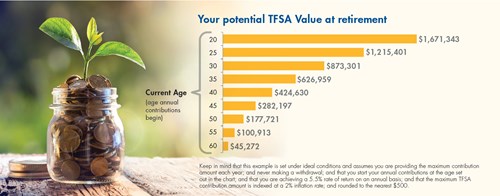The Tax-Free Savings Account (TFSA) can be a misunderstood savings tool. Considered by some to be a short-term investment, many of us do not value its long-term savings potential. If you’re in your 20’s, you have time on your side and are well positioned to make (or exceed) a million dollars of tax- free savings by retirement. If you’re getting a late start with investing, don’t worry. Individuals in their 30’s, 40’s and 50’s can still accumulate significant tax-free savings by the time they’re ready to retire.
The chart below illustrates the potential value of a TFSA at age 65, provided you deposit the maximum contribution amount each year, never make a withdrawal, and start your annual contributions at the age set out in the chart.
Your potential TFSA value at retirement

The chart assumes a 5.5% rate of return on an annual basis. The maximum TFSA contribution amount is indexed to a 2% inflation rate and rounded to the nearest $500.
A powerful savings tool
When you invest in a TFSA, you will never be taxed on the growth you earn or on a withdrawal. Canadians who are at least 18 years old earn new contribution room every year, and that contribution room is cumulative. That means you can make extra deposits if you haven’t contributed the maximum amount in previous years. If you do make a withdrawal, your contribution room is regained the following year. This makes a TFSA one of the most flexible savings vehicles available.
Many Canadians underestimate the earning potential of a TFSA and use it for modest short-term savings goals. Often people are unaware of the variety of investment options, and are surprised to find that a TFSA can be much more than just a low-interest savings account. TFSAs can hold term investments, segregated funds, mutual funds and individual securities such as stocks and bonds.
Tax-free income in retirement
A TFSA also provides tax-free income. If you will be receiving income from a pension plan or Registered Retirement Savings Plan (RRSP) in retirement, an alternate source of tax-free income is beneficial as it allows you to draw income when you need it – without worrying about how it will impact your taxes.
Some additional benefits are:
- Withdrawals from a TFSA don’t affect your eligibility to receive Old Age Security (OAS), Guaranteed Income Supplement (GIS), goods and services tax (GST) credit, or other income-tested benefits and tax credits.
- Unlike an RSP, a TFSA doesn’t need to be converted to an income product at age 71.
- Your estate will not be burdened with a hefty tax bill after your death, as is often the case with an RSP.
- If you need access to some of your savings before retirement, you’re able to access it on a tax-free basis, without tax consequences, or repayment requirements.
Talk to your financial advisor to find out how a TFSA can help you reach your savings goals.
This information does not constitute legal, tax or other professional advice. The information contained is consistent with current CRA rules and maximum annual contribution limit of $7,000, which are subject to change without notice.

